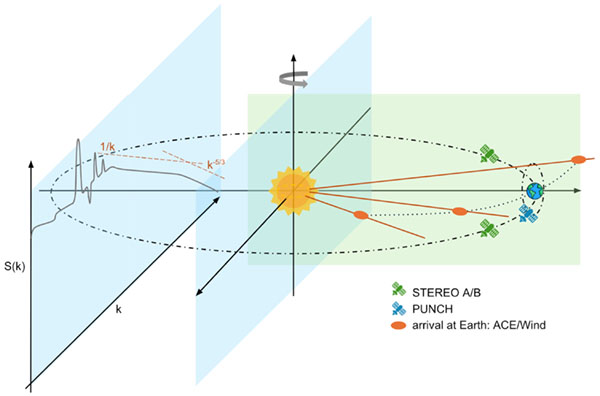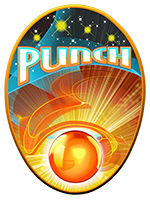1/ƒ noise in the heliosphere: a target for PUNCH science
This is a PUNCH Science Nugget
This article is based on the third paper in the collection PUNCH Mission: An Overview – A Topical Issue of Solar Physics.

Projected fields of view of STEREO A/B (green plane) and PUNCH (blue plane), both perpendicular to the ecliptic plane. Wind parcels that have reached or will reach Earth as observed by ACE/Wind are labeled in orange, using the simple assumption that solar wind corotates rigidly with the Sun. Whether heliospheric 1/ƒ seen in in-situ temporal spectrum can be traced back to 1/k spatial structure near the solar corona remains an open question for PUNCH to address.
Scale-invariant 1/ƒ noise is a familiar observation across a wide array of natural and artificial systems, including heart rate fluctuations and loudness patterns in musical compositions. In the solar wind, it is seen mostly in the magnetic field energy spectrum across timescales from minutes to several days, where it represents fluctuations with equal power per frequency octave. First identified in the heliosphere in the 1980s, 1/ƒ noise has prompted ongoing discussion concerning its generation mechanism and place of origin – whether it forms locally in the solar wind or, as suggested by the long timescale of its influence, it stems from deeper solar processes linked to coronal dynamics and the solar dynamo. NASA’s PUNCH mission will capture high-resolution images of the inner solar wind and the corona, allowing studies of the spatial structures of the plasma that may be associated with the 1/ƒ observations1, with the potential to reveal the origin and evolution of these enigmatic heliospheric 1/ƒ signals. In preparation for these new observations, PhD student Victoria Wang (working with PUNCH Co-Investigator William Matthaeus) and colleagues have reviewed the current state of our understanding of in the heliosphere as our third featured paper from the Solar Physics PUNCH Mission Overview Topical Issue (J. Wang et al., Solar Physics, 2024, 299:169).
1 Preliminary studies have already been conducted to translate PUNCH images into spectral information. These involve 3D reconstructions from Thomson scattering and comparisons with magnetohydrodynamic simulations. See PUNCH Topical Issue Paper 2 Science nugget (F. Pecora et al., Solar Physics, 2024, 299:137)
PUNCH science nuggets are archived on our News Page.
You can subscribe to PUNCH nuggets by email.
NASA official releases about PUNCH are at the NASA PUNCH blog.



